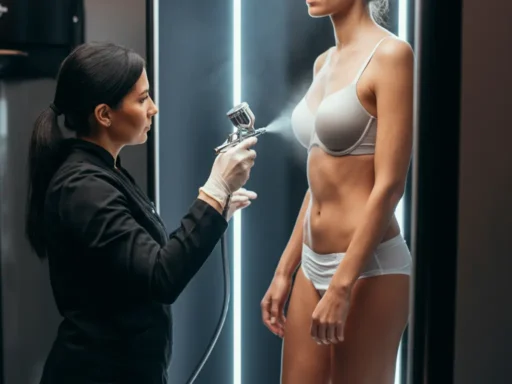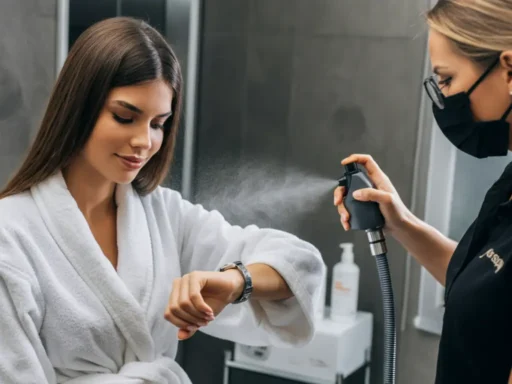Feeling self-conscious about stretch marks is incredibly common, and many people seek simple, non-invasive options to address these concerns. Among the most popular solutions is spray tanning, but does spray tan cover stretch marks effectively? While spray tans might not permanently erase stretch marks, they can improve their appearance and boost your confidence.
This article explores how spray tanning interacts with stretch marks, what results you can realistically expect, and pro tips for achieving the best coverage.
- Understanding Stretch Marks
- How Spray Tanning Works on Skin and Stretch Marks
- Can Spray Tan Cover Stretch Marks or Just Minimize Them?
- Will a Spray Tan Hide Stretch Marks for Everyone?
- Pro Tips for Natural-Looking Coverage Over Stretch Marks
- The Limitations of Spray Tans for Stretch Marks
- Long-Term Alternatives to Address Stretch Marks
- Conclusion
- Frequently Asked Questions (FAQs)
Understanding Stretch Marks
What Causes Stretch Marks and Why Are They So Visible?
Stretch marks, also known as striae are formed when the skin expands or contracts too quickly and leads to degradation of the collagen and elastin. This tearing creates thin, scar-like lines that can appear anywhere on the body, such as the stomach, thighs, or arms.
Their visibility often depends on two factors:
1
Skin discoloration:
New stretch marks tend to be red, purple, or brown, while older ones fade to silvery-white.
2
Texture:
Stretch-marked skin can feel thinner or have a slightly indented texture, making it reflect light differently from surrounding skin.
Types of Stretch Marks and Their Characteristics
The characteristics of stretch marks can affect how well they respond to spray tanning.
New Stretch Marks (red or purple)
These can be more noticeable due to the contrast in color, but they generally absorb tanning solution more evenly.
Old Stretch Marks (white or silver)
These marks often lack pigment, which can affect how they interact with spray tanning products.
How Spray Tanning Works on Skin and Stretch Marks
What is DHA and How Does It Tan the Skin?
Spray tanning relies on dihydroxyacetone (DHA), a non-toxic chemical that reacts with amino acids on the outer layer of the skin. This reaction temporarily darkens the skin, creating a tanned appearance. The intensity of the tan depends on the DHA concentration in the formula.
Why Stretch Marks May React Differently
Stretch marks may not tan the same way as surrounding skin for three main reasons:
1
Pigment loss:
Older stretch marks lack melanin, making it harder to absorb DHA.
2
Texture differences:
Uneven skin texture may cause inconsistent application of the tanning solution.
3
Absorption rate:
The smooth, thin nature of stretch-marked skin can lead to patchy or lighter results in those areas.
Can Spray Tan Cover Stretch Marks or Just Minimize Them?
The question “can spray tan cover stretch marks?” depends on the individual’s skin and the characteristics of their stretch marks. A spray tan usually does not cover the stretch marks, but blends them with the other skin color, so they become less noticeable.
For best results, newer, pigmented stretch marks tend to respond better, while older, silvery marks may require additional techniques for more effective camouflage.
Will a Spray Tan Hide Stretch Marks for Everyone?
The short answer to will a spray tan hide stretch marks is that results vary depending on multiple factors.
Skin Tone and Mark Color Considerations
- For light skin tones, spray tans can help reduce the stark contrast between the stretch marks and surrounding skin.
- For darker skin tones, spray tans may only minimally reduce visibility due to less contrasting pigmentation.
Impact of Skin Texture and Hydration Levels
- Even hydration of the skin helps create smoother application and minimizes uneven tanning.
- Deeply textured marks, such as those with more pronounced indentations, may still remain visible under certain lighting or angles.
Pro Tips for Natural-Looking Coverage Over Stretch Marks
Pre-Tan Prep: Exfoliation and Moisture
Exfoliate gently to remove dead skin cells for an even application. Focus on the areas with stretch marks. Apply non-oily moisturizer daily leading up to your session, particularly on stretch marks, to ensure the skin absorbs the tan evenly.
Spray Technique: Double Coating and Shading
Skilled spray tan professionals can use double coating in areas with stretch marks to create better blending. Sophisticated shading techniques can give the illusion of a smoother and more even skin tone.
Choosing the Right Shade and Formula
Pick a formula with a lower DHA concentration for a gradual and natural effect. Avoid overly dark shades, as they may emphasize stretch mark textures.
The Limitations of Spray Tans for Stretch Marks
While spray tanning can work wonders for a confidence boost, it’s not a miracle solution.
Deep or pigment-free stretch marks may remain visible despite a tanning session.
Lighting conditions, body movement, and how the tan fades over time can reveal the underlying texture or color differences.
Long-Term Alternatives to Address Stretch Marks
If you’re looking for more permanent improvements, consider pairing tanning with these options:
Microneedling or Laser Treatments for collagen stimulation and faster skin repair.
Stretch Mark Creams and Retinoids, which can improve skin texture and reduce discoloration over time.
Combining treatments with spray tanning for maximum cosmetic coverage while enhancing skin healing.
Conclusion
Does stretch mark cover spray tan? Although it cannot erase them, it can go a long way in making them less visible, which helps an individual self-conscious of his/her looks to gain some measure of confidence. Just remember to pair spray tanning with proper preparation and realistic expectations.
Want to see the difference for yourself? Book a session with a trusted spray tan professional and enjoy the benefits of smooth, radiant skin today!
Frequently Asked Questions (FAQs)
No, a properly applied spray tan usually minimizes their visibility rather than accentuates them.
Yes, self-tanners can achieve similar blending effects. However, professional spray tans often deliver smoother and more even results.
It’s recommended to refresh your tan every 7-10 days, depending on your lifestyle and how quickly your skin exfoliates naturally.
Tans tend to work better on newer marks that still have some pigment compared to older, silver-toned ones.
Yes, certain formulas, like tinted body bronzers or mousse products with higher DHA content, are targeted for such purposes.






